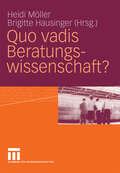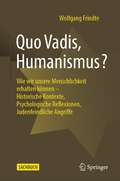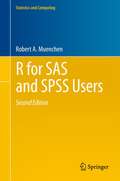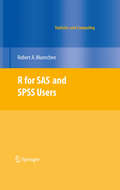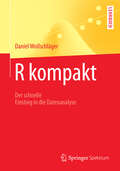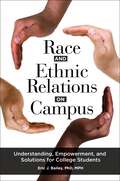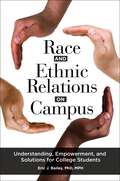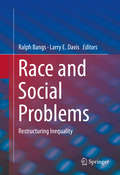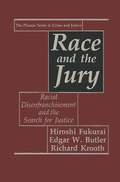- Table View
- List View
Quo Vadis, Humanismus?: Wie wir unsere Menschlichkeit erhalten können - Historische Kontexte, Psychologische Reflexionen, Judenfeindliche Angriffe
by Wolfgang FrindteWie steht es mit den humanistischen Grundlagen unseres Lebens und Zusammenlebens? Müssen wir uns nicht gerade heute dieser Fundamente versichern? Wer greift diese Fundamente an? Um diese Fragen beantworten zu können, nutzt der Autor ein Konstruktionsprinzip, mit dem die humanistischen Anstrengungen seit Petrarca in dreifacher Weise gerahmt werden: Zum einen werden diese Anstrengungen in die jeweiligen historischen Kontexte eingeordnet; zum zweiten greift er auf Reflexionen zurück, die sich in den verschiedenen Entwicklungsetappen der Psychologie explizit oder implizit auf den Humanismus beziehen; drittens schließlich macht er auf judenfeindliche und antisemitische Äußerungen, Vorurteile, Diskriminierungen und Vernichtungsexzesse aufmerksam, um die Ambivalenzen der verschiedenen humanistischen Anstrengungen zu verdeutlichen. Denn, so der Autor, die Einstellung und das Verhalten gegenüber Jüdinnen und Juden sind der Lackmustest eines jeglichen Humanismus.
The Quotable Jung
by C. G. Jung Judith Harris Tony WoolfsonC. G. Jung (1875–1961) was a preeminent thinker of the modern era. In seeking to establish an interdisciplinary science of analytical psychology, he studied psychiatry, religion, mysticism, literature, physics, biology, education, and criminology. He introduced the concepts of extraversion and introversion, and terms such as complex, archetype, individuation, and the collective unconscious. He stressed the primacy of finding meaning in our lives.The Quotable Jung is the single most comprehensive collection of Jung quotations ever assembled. It is the essential introduction for anyone new to Jung and the Jungian tradition. It will also inspire those familiar with Jung to view him in an entirely new way. The Quotable Jung presents hundreds of the most representative selections from the vast array of Jung's books, essays, correspondence, lectures, seminars, and interviews, as well as the celebrated Red Book, in which Jung describes his own fearsome confrontation with the unconscious. Organized thematically, this collection covers such topics as the psyche, the symbolic life, dreams, the analytic process, good and evil, creativity, alchemical transformation, death and rebirth, the problem of the opposites, and more. The quotations are arranged so that the reader can follow the thread of Jung’s thought on these topics while gaining an invaluable perspective on his writings as a whole.Succinct and accessible, The Quotable Jung also features a preface by Judith Harris and a detailed chronology of Jung’s life and work.The single most comprehensive collection of Jung quotations ever assembledFeatures hundreds of quotesCovers such topics as the psyche, dreams, good and evil, death and rebirth, and moreIncludes a detailed chronology of Jung’s life and workServes as the ideal introduction to Jung and the Jungian tradition
The Quotable Jung
by C. G. Jung Judith Harris Tony WoolfsonC. G. Jung (1875–1961) was a preeminent thinker of the modern era. In seeking to establish an interdisciplinary science of analytical psychology, he studied psychiatry, religion, mysticism, literature, physics, biology, education, and criminology. He introduced the concepts of extraversion and introversion, and terms such as complex, archetype, individuation, and the collective unconscious. He stressed the primacy of finding meaning in our lives.The Quotable Jung is the single most comprehensive collection of Jung quotations ever assembled. It is the essential introduction for anyone new to Jung and the Jungian tradition. It will also inspire those familiar with Jung to view him in an entirely new way. The Quotable Jung presents hundreds of the most representative selections from the vast array of Jung's books, essays, correspondence, lectures, seminars, and interviews, as well as the celebrated Red Book, in which Jung describes his own fearsome confrontation with the unconscious. Organized thematically, this collection covers such topics as the psyche, the symbolic life, dreams, the analytic process, good and evil, creativity, alchemical transformation, death and rebirth, the problem of the opposites, and more. The quotations are arranged so that the reader can follow the thread of Jung’s thought on these topics while gaining an invaluable perspective on his writings as a whole.Succinct and accessible, The Quotable Jung also features a preface by Judith Harris and a detailed chronology of Jung’s life and work.The single most comprehensive collection of Jung quotations ever assembledFeatures hundreds of quotesCovers such topics as the psyche, dreams, good and evil, death and rebirth, and moreIncludes a detailed chronology of Jung’s life and workServes as the ideal introduction to Jung and the Jungian tradition
R.D. Laing and the Paths of Anti-Psychiatry (Makers of Modern Psychotherapy)
by Zbigniew KotowiczIn the 1960s and 1970s, the radical and visionary ideas of R. D. Laing revolutionized thinking about psychiatric practice and the meaning of madness. His work, from The Divided Self to Knots, and his therapeutic community at Kingsley Hall, made him a household name. But after little more than a decade he faded from prominence as quickly as he had attained it. R.D.Laing and the Paths of Anti-Psychiatry re-examines Laing's work in the context of the anti-psychiatry movement. Concentrating on his most productive decade, the author provides a reasoned critique of Laing's theoretical writings, investigates the influences on his thinking such as phenomenology, existentialism and American family interaction research, and considers the experimental Kingsley Hall therapeutic community in comparison with anti-psychiatry experiments in Germany and Italy. The book provides a much needed reassessment and re-evaluation of Laing's work and its significance for psychotherapy and psychiatry today.
R.D. Laing and the Paths of Anti-Psychiatry (Makers of Modern Psychotherapy)
by Zbigniew KotowiczIn the 1960s and 1970s, the radical and visionary ideas of R. D. Laing revolutionized thinking about psychiatric practice and the meaning of madness. His work, from The Divided Self to Knots, and his therapeutic community at Kingsley Hall, made him a household name. But after little more than a decade he faded from prominence as quickly as he had attained it. R.D.Laing and the Paths of Anti-Psychiatry re-examines Laing's work in the context of the anti-psychiatry movement. Concentrating on his most productive decade, the author provides a reasoned critique of Laing's theoretical writings, investigates the influences on his thinking such as phenomenology, existentialism and American family interaction research, and considers the experimental Kingsley Hall therapeutic community in comparison with anti-psychiatry experiments in Germany and Italy. The book provides a much needed reassessment and re-evaluation of Laing's work and its significance for psychotherapy and psychiatry today.
R Data Analysis without Programming
by David W. GerbingThis book prepares readers to analyze data and interpret statistical results using R more quickly than other texts. R is a challenging program to learn because code must be created to get started. To alleviate that challenge, Professor Gerbing developed lessR. LessR extensions remove the need to program. By introducing R through less R, readers learn how to organize data for analysis, read the data into R, and produce output without performing numerous functions and programming exercises first. With lessR, readers can select the necessary procedure and change the relevant variables without programming. The text reviews basic statistical procedures with the lessR enhancements added to the standard R environment. Through the use of lessR, R becomes immediately accessible to the novice user and easier to use for the experienced user. Highlights of the book include: Quick Starts that introduce readers to the concepts and commands reviewed in the chapters. Margin notes that highlight,define,illustrate,and cross-reference the key concepts.When readers encounter a term previously discussed, the margin notes identify the page number to the initial introduction. Scenarios that highlight the use of a specific analysis followed by the corresponding R/lessR input and an interpretation of the resulting output. Numerous examples of output from psychology, business, education, and other social sciences, that demonstrate how to interpret results. Two data sets provided on the website and analyzed multiple times in the book, provide continuity throughout. End of chapter worked problems help readers test their understanding of the concepts. A website at www.lessRstats.com that features the lessR program, the book’s data sets referenced in standard text and SPSS formats so readers can practice using R/lessR by working through the text examples and worked problems, PDF slides for each chapter, solutions to the book’s worked problems, links to R/lessR videos to help readers better understand the program, and more. An ideal supplement for graduate or advanced undergraduate courses in statistics, research methods, or any course in which R is used, taught in departments of psychology, business, education, and other social and health sciences, this book is also appreciated by researchers interested in using R for their data analysis. Prerequisites include basic statistical knowledge. Knowledge of R is not assumed.
R Data Analysis without Programming
by David W. GerbingThis book prepares readers to analyze data and interpret statistical results using R more quickly than other texts. R is a challenging program to learn because code must be created to get started. To alleviate that challenge, Professor Gerbing developed lessR. LessR extensions remove the need to program. By introducing R through less R, readers learn how to organize data for analysis, read the data into R, and produce output without performing numerous functions and programming exercises first. With lessR, readers can select the necessary procedure and change the relevant variables without programming. The text reviews basic statistical procedures with the lessR enhancements added to the standard R environment. Through the use of lessR, R becomes immediately accessible to the novice user and easier to use for the experienced user. Highlights of the book include: Quick Starts that introduce readers to the concepts and commands reviewed in the chapters. Margin notes that highlight,define,illustrate,and cross-reference the key concepts.When readers encounter a term previously discussed, the margin notes identify the page number to the initial introduction. Scenarios that highlight the use of a specific analysis followed by the corresponding R/lessR input and an interpretation of the resulting output. Numerous examples of output from psychology, business, education, and other social sciences, that demonstrate how to interpret results. Two data sets provided on the website and analyzed multiple times in the book, provide continuity throughout. End of chapter worked problems help readers test their understanding of the concepts. A website at www.lessRstats.com that features the lessR program, the book’s data sets referenced in standard text and SPSS formats so readers can practice using R/lessR by working through the text examples and worked problems, PDF slides for each chapter, solutions to the book’s worked problems, links to R/lessR videos to help readers better understand the program, and more. An ideal supplement for graduate or advanced undergraduate courses in statistics, research methods, or any course in which R is used, taught in departments of psychology, business, education, and other social and health sciences, this book is also appreciated by researchers interested in using R for their data analysis. Prerequisites include basic statistical knowledge. Knowledge of R is not assumed.
R Data Analysis without Programming: Explanation and Interpretation
by David W. GerbingThe new edition of this innovative book, R Data Analysis without Programming, prepares the readers to quickly analyze data and interpret statistical results using R. Professor Gerbing has developed lessR, a ground-breaking method in alleviating the challenges of R programming. The lessR extends R, removing the need for programming. This edition expands upon the first edition’s introduction to R through lessR, which enables the readers to learn how to organize data for analysis, read the data into R, and generate output without performing numerous functions and programming exercises first. With lessR, readers can select the necessary procedure and change the relevant variables with simple function calls. The text reviews and explains basic statistical procedures with the lessR enhancements added to the standard R environment. Using lessR, data analysis with R becomes immediately accessible to the novice user and easier to use for the experienced user. Highlights along with content new to this edition include: Explanation and Interpretation of all data analysis techniques; much more than a computer manual, this book shows the reader how to explain and interpret the results. Introduces the concepts and commands reviewed in each chapter. Clear, relaxed writing style more effectively communicates the underlying concepts than more stilted academic writing. Extensive margin notes highlight, define, illustrate, and cross-reference the key concepts. When readers encounter a term previously discussed, the margin notes identify the page number for the initial introduction. Scenarios that highlight the use of a specific analysis followed by the corresponding R/lessR input, output, and an interpretation of the results. Numerous examples of output from psychology, business, education, and other social sciences, that demonstrate the analysis and how to interpret results. Two data sets are analyzed multiple times in the book, provide continuity throughout. Comprehensive: A wide range of data analysis techniques are presented throughout the book. Integration with machine learning as regression analysis is presented from both the traditional perspective and from the modern machine learning perspective. End of chapter problems help readers test their understanding of the concepts. A website at www.lessRstats.com that features the data sets referenced in both standard text and SPSS formats so readers can practice using R/lessR by working through the text examples and worked problems, R/lessR videos to help readers better understand the program, and more. This book is ideal for graduate and undergraduate courses in statistics beyond the introductory course, research methods, and/or any data analysis course, taught in departments of psychology, business, education, and other social and health sciences; this book is also appreciated by researchers doing data analysis. Prerequisites include basic statistical knowledge, though the concepts are explained from the beginning in the book. Previous knowledge of R is not assumed.
R Data Analysis without Programming: Explanation and Interpretation
by David W. GerbingThe new edition of this innovative book, R Data Analysis without Programming, prepares the readers to quickly analyze data and interpret statistical results using R. Professor Gerbing has developed lessR, a ground-breaking method in alleviating the challenges of R programming. The lessR extends R, removing the need for programming. This edition expands upon the first edition’s introduction to R through lessR, which enables the readers to learn how to organize data for analysis, read the data into R, and generate output without performing numerous functions and programming exercises first. With lessR, readers can select the necessary procedure and change the relevant variables with simple function calls. The text reviews and explains basic statistical procedures with the lessR enhancements added to the standard R environment. Using lessR, data analysis with R becomes immediately accessible to the novice user and easier to use for the experienced user. Highlights along with content new to this edition include: Explanation and Interpretation of all data analysis techniques; much more than a computer manual, this book shows the reader how to explain and interpret the results. Introduces the concepts and commands reviewed in each chapter. Clear, relaxed writing style more effectively communicates the underlying concepts than more stilted academic writing. Extensive margin notes highlight, define, illustrate, and cross-reference the key concepts. When readers encounter a term previously discussed, the margin notes identify the page number for the initial introduction. Scenarios that highlight the use of a specific analysis followed by the corresponding R/lessR input, output, and an interpretation of the results. Numerous examples of output from psychology, business, education, and other social sciences, that demonstrate the analysis and how to interpret results. Two data sets are analyzed multiple times in the book, provide continuity throughout. Comprehensive: A wide range of data analysis techniques are presented throughout the book. Integration with machine learning as regression analysis is presented from both the traditional perspective and from the modern machine learning perspective. End of chapter problems help readers test their understanding of the concepts. A website at www.lessRstats.com that features the data sets referenced in both standard text and SPSS formats so readers can practice using R/lessR by working through the text examples and worked problems, R/lessR videos to help readers better understand the program, and more. This book is ideal for graduate and undergraduate courses in statistics beyond the introductory course, research methods, and/or any data analysis course, taught in departments of psychology, business, education, and other social and health sciences; this book is also appreciated by researchers doing data analysis. Prerequisites include basic statistical knowledge, though the concepts are explained from the beginning in the book. Previous knowledge of R is not assumed.
R for SAS and SPSS Users (Statistics and Computing)
by Robert A. MuenchenR is a powerful and free software system for data analysis and graphics, with over 5,000 add-on packages available. This book introduces R using SAS and SPSS terms with which you are already familiar. It demonstrates which of the add-on packages are most like SAS and SPSS and compares them to R's built-in functions. It steps through over 30 programs written in all three packages, comparing and contrasting the packages' differing approaches. The programs and practice datasets are available for download.The glossary defines over 50 R terms using SAS/SPSS jargon and again using R jargon. The table of contents and the index allow you to find equivalent R functions by looking up both SAS statements and SPSS commands. When finished, you will be able to import data, manage and transform it, create publication quality graphics, and perform basic statistical analyses. This new edition has updated programming, an expanded index, and even more statistical methods covered in over 25 new sections.
R for SAS and SPSS Users (Statistics and Computing #Vol. 9)
by Robert A. MuenchenWhile SAS and SPSS have many things in common, R is very different. My goal in writing this book is to help you translate what you know about SAS or SPSS into a working knowledge of R as quickly and easily as possible. I point out how they differ using terminology with which you are familiar, and show you which add-on packages will provide results most like those from SAS or SPSS. I provide many example programs done in SAS, SPSS, and R so that you can see how they compare topic by topic. When finished, you should be able to use R to: Read data from various types of text files and SAS/SPSS datasets. Manage your data through transformations or recodes, as well as splitting, merging and restructuring data sets. Create publication quality graphs including bar, histogram, pie, line, scatter, regression, box, error bar, and interaction plots. Perform the basic types of analyses to measure strength of association and group differences, and be able to know where to turn to cover much more complex methods.
R.H. Lotze: Medicinische Psychologie oder die Physiologie der Seele (Klassische Texte der Wissenschaft)
by Nikolay MilkovOriginaltext mit philosophischen sowie historischen Kommentaren von Nikolay Milkov Als habilitierter Mediziner und Philosoph hat Rudolph Hermann Lotze durch seinen interdisziplinären Ansatz die Entwicklung der Psychologie im 19. Jahrhundert wie kein anderer geprägt. Im Unterschied zu anderen Wissenschaftlern der Zeit hat Lotze die neue Disziplin konsequent in enger Verbindung mit der Philosophie betrachtet, wie besonders in Medicinische Psychologie oder Physiologie der Seele (1852) deutlich wird. Dies bedeutete seine bewusste Abkehr von der Herangehensweise, die Psychologie ganz über experimentelle Untersuchungen und damit die Empirie zu definieren. Lotze scheute sich jedoch, diese entstehende Disziplin „philosophische Psychologie“ zu nennen, für ihn war sie nur physiologische Psychologie, herausgearbeitet mit Hilfe der Philosophie: Sie stellt Tatsachen fest und untersucht, wie Körper und Seele sich zueinander verhalten, tut dies jedoch nicht nur empirisch, sondern auch „metaphysisch“. In diesem Band wird Lotzes Originaltext untersucht, kommentiert und eingebettet in den soziokulturellen Hintergrund der Entstehungszeit, um einen tiefen, aber verständlichen Einblick in diesen Bereich der Psychologie zu geben.
R kompakt: Der schnelle Einstieg in die Datenanalyse (Springer-Lehrbuch)
by Daniel WollschlägerDie kompakte Einführung in die praktische Datenauswertung mit der freien Statistikumgebung R. Das Buch gibt einen Überblick über die Arbeit mit R mit dem Ziel, einen schnellen Einstieg in die grafische und deskriptive Datenauswertung sowie in die Umsetzung der wichtigsten statistischen Tests zu ermöglichen. Neben den klassischen univariaten Verfahren berücksichtigt es auch nonparametrische und multivariate Methoden. Zudem deckt es die vielfältigen Möglichkeiten ab, Diagramme zu erstellen, Daten mit anderen Programmen auszutauschen und R durch Zusatzpakete zu erweitern. Die statistischen Verfahren werden an Beispielen erläutert und an vielen Stellen mit Diagrammen illustriert. Das Buch richtet sich an alle, die R kennenlernen und in konkreten Aufgabenstellungen einsetzen möchten, ohne bereits über Vorerfahrungen mit befehlsgesteuerten Programmen oder Programmiersprachen zu verfügen.
Rabbi Akiva's Philosophy of Love
by Naftali RothenbergThis book explores the philosophy of love through the thought and life of Rabbi Akiva ben Joseph. Readers of the Talmud are introduced to Rabbi Akiva through the iconic story of his love for his wife Rachel. From this starting point, Naftali Rothenberg conducts a thorough examination of the harmonious approach to love in the obstacle-laden context of human reality. Discussing the deterioration of passion into simple lust, the ability to contend with suffering and death, and so forth, Rothenberg addresses the deepest and most pressing questions about human love. The readings and observations offered here allow readers to acquire the wisdom of love—not merely as an assemblage of theoretical arguments and abstract statements, but as an analysis of the internal contradictions and difficulties revealed in the context of attempts to realize and implement harmonious love.
Rabbi Akiva's Philosophy of Love
by Naftali RothenbergThis book explores the philosophy of love through the thought and life of Rabbi Akiva ben Joseph. Readers of the Talmud are introduced to Rabbi Akiva through the iconic story of his love for his wife Rachel. From this starting point, Naftali Rothenberg conducts a thorough examination of the harmonious approach to love in the obstacle-laden context of human reality. Discussing the deterioration of passion into simple lust, the ability to contend with suffering and death, and so forth, Rothenberg addresses the deepest and most pressing questions about human love. The readings and observations offered here allow readers to acquire the wisdom of love—not merely as an assemblage of theoretical arguments and abstract statements, but as an analysis of the internal contradictions and difficulties revealed in the context of attempts to realize and implement harmonious love.
Rabbi Akiva's Philosophy of Love
by Naftali RothenbergThis book explores the philosophy of love through the thought and life of Rabbi Akiva ben Joseph. Readers of the Talmud are introduced to Rabbi Akiva through the iconic story of his love for his wife Rachel. From this starting point, Naftali Rothenberg conducts a thorough examination of the harmonious approach to love in the obstacle-laden context of human reality. Discussing the deterioration of passion into simple lust, the ability to contend with suffering and death, and so forth, Rothenberg addresses the deepest and most pressing questions about human love. The readings and observations offered here allow readers to acquire the wisdom of love—not merely as an assemblage of theoretical arguments and abstract statements, but as an analysis of the internal contradictions and difficulties revealed in the context of attempts to realize and implement harmonious love.
The Race Against Time: Psychotherapy and Psychoanalysis in the Second Half of Life (Critical Issues in Psychiatry)
by Robert A. Nemiroff Calvin A. ColarussoThis is the second book in the pioneering investigation of adult develop ment by Robert A. Nemiroff and Calvin A. Colarusso. The first, Adult Development: A New Dimension in Psychodynamic Theory and Practice, ar rived to critical acclaim in 1981. It presented a psychodynamic theory of development during the second half of life and a model of normal adult functioning. This book is the logical sequel, expanding and elaborating the original formulations and applying them to the clinical practice of psychotherapy and psychoanalysis. Nemiroff and Colarusso demonstrate that these are appropriate techniques for patients in the second half of life, regardless of age. They lay to rest many stereotypes and myths that have long interfered with the dynamic treatment of older patients, and they propose exciting new conceptualizations such as that of adult develop mental arrests. The genetic approach reaches beyond childhood and adolescence and takes on important new meaning by incorporating an adult developmental past that influences both psychopathology and transference. The relationship between theory and therapy is richly demonstrated in the clinical presentations, including ten detailed case histories of pa tients between the ages of 40 and BO. These and other clinical discussions provide ample evidence that a psychodynamic approach that is based on a sound adult developmental psychology can be extraordinarily effective. They also demonstrate both the similarities and differences in working with older versus younger patients. This work is a major contribution in a long-neglected dimension of clinical psychiatry. SHERWYN M.
Race and Culture: Tools, Techniques and Trainings: A Manual for Professionals (The Systemic Thinking and Practice Series)
by Sumita Dutta Reenee Singh"Race" and Culture: Tools, Techniques and Trainings is a practical resource for trainers who wish to work with the issues raised by racial and cultural diversity in their own agency settings. It is intended as an easy guide and a "hands-on" tool for practitioners (family therapists, clinical psychologists, social workers, GPs, nurses, health visitors, counsellors, teachers, etc), academics, educators and students. It brings together contributions from professional trainers working in multiple and diverse settings. It is aimed both at those who would like to initiate training on diversity in their agency contexts or those who wish to include the important dimensions of "race" and culture into their existing trainings. This book emerged directly from training developed by the authors for professionals working with refugees in their own communities, at the Centre for Cross Cultural Studies at the Institute of Family Therapy.
Race and Culture: Tools, Techniques and Trainings: A Manual for Professionals (The Systemic Thinking and Practice Series)
by Sumita Dutta Reenee Singh"Race" and Culture: Tools, Techniques and Trainings is a practical resource for trainers who wish to work with the issues raised by racial and cultural diversity in their own agency settings. It is intended as an easy guide and a "hands-on" tool for practitioners (family therapists, clinical psychologists, social workers, GPs, nurses, health visitors, counsellors, teachers, etc), academics, educators and students. It brings together contributions from professional trainers working in multiple and diverse settings. It is aimed both at those who would like to initiate training on diversity in their agency contexts or those who wish to include the important dimensions of "race" and culture into their existing trainings. This book emerged directly from training developed by the authors for professionals working with refugees in their own communities, at the Centre for Cross Cultural Studies at the Institute of Family Therapy.
Race and Ethnic Relations on Campus: Understanding, Empowerment, and Solutions for College Students
by Eric J. BaileyCan college students confront race relations issues directly and make positive changes? Yes, they can. This book provides a fresh, practical approach to addressing these issues—individually and collectively—to ignite a positive revolution in race and ethnic relations.As racial and ethnic incidents continue to occur at college campuses across the nation, an esteemed African American professor who teaches in the heart of a region that has seen some of the most volatile racial incidents in American history breaks the uneasy silence to respond to growing concerns from undergraduate students. In Race and Ethnic Relations on Campus: Understanding, Empowerment, and Solutions for College Students, Eric J. Bailey presents a new approach to addressing and better understanding the major controversial issues associated with race and ethnic relations for today's college students.This book confronts commonplace race relations issues directly and sets forth a completely different way of addressing these problems that empowers today's college students to take charge and start to effect change—to do something about racially charged conflict rather than to simply talk about it. The chapters describe how race and ethnic relations issues typically arise on college campuses, share insight into how national incidents affect college students' reactions to incidents on their own campus, and identify the negative consequences of poor race relations as well as describe the positive effects of good race relations.
Race and Ethnic Relations on Campus: Understanding, Empowerment, and Solutions for College Students
by Eric J. BaileyCan college students confront race relations issues directly and make positive changes? Yes, they can. This book provides a fresh, practical approach to addressing these issues—individually and collectively—to ignite a positive revolution in race and ethnic relations.As racial and ethnic incidents continue to occur at college campuses across the nation, an esteemed African American professor who teaches in the heart of a region that has seen some of the most volatile racial incidents in American history breaks the uneasy silence to respond to growing concerns from undergraduate students. In Race and Ethnic Relations on Campus: Understanding, Empowerment, and Solutions for College Students, Eric J. Bailey presents a new approach to addressing and better understanding the major controversial issues associated with race and ethnic relations for today's college students.This book confronts commonplace race relations issues directly and sets forth a completely different way of addressing these problems that empowers today's college students to take charge and start to effect change—to do something about racially charged conflict rather than to simply talk about it. The chapters describe how race and ethnic relations issues typically arise on college campuses, share insight into how national incidents affect college students' reactions to incidents on their own campus, and identify the negative consequences of poor race relations as well as describe the positive effects of good race relations.
Race and Social Problems: Restructuring Inequality
by Ralph Bangs Larry E. DavisAs much as Americans believe in the promise of an egalitarian, color-blind society, the reality is far from that ideal. People of color consistently lag behind their white counterparts in key quality-of-life areas. Despite many significant gains, widespread structural inequalities continue to exist and thrive. Race and Social Problems takes the long view of this state of affairs, offering both multi-level analysis and a practical blueprint for social justice. It begins by explaining how race-related social problems have changed over the decades. This volume identifies factors contributing to their persistence in this century, most notably the central role of economic disparities in exacerbating related social problems and replicating them for future generations. The chapters expand on this knowledge by detailing innovative and successful strategies for addressing aspects of six major areas of inequality: Poverty: challenging standard American concepts of poverty.Education: approaches toward closing the achievement gap.Intergroup relations: enhancing race dialogues.Family and lifespan: programs targeting families, youth, and elderly.Criminal justice: reducing incarceration and increasing public safety.Health and mental health: promoting positive outcomes. Race and Social Problems casts a wide net across the most pressing social issues, clarifying both the immediate and larger tasks ahead for a range of professionals in such diverse fields as social work, anthropology, communications, criminology, economics, history, law, political science, psychology, public health, and sociology.
Race and the Jury: Racial Disenfranchisement and the Search for Justice (The Plenum Series in Crime and Justice)
by Hiroshi Fukurai Edgar W. Butler Richard KroothIn this timely volume, the authors provide a penetrating analysis of the institutional mechanisms perpetuating the related problems of minorities' disenfranchisement and their underrepresentation on juries.
Race and the Unconscious: An Africanist Depth Psychology Perspective on Dreaming
by Fanny BrewsterRace and the Unconscious engages the archetypal African consciousness that enriches our knowledge regarding the foundational mythopoetic of Africanist dreaming. Featuring crucial historical context, Jungian and post-Jungian theory, clinical case studies, and dream series interpretations, the book offers readers a rich framework for exploring and understanding the language, images, and symbols of African and African American dreamlife. It expands the modern understanding of dreaming with the inclusion of Africanist perspectives, philosophy, and mythology while emphasizing the potential for and process of psychological healing through dreamwork. Race and the Unconscious is a must-read for Jungian analysts and analytical psychologists in practice and in training, as well as anyone interested in understanding psychological processes inclusive of those of African descent and their culture, including academics and students of sociology, anthropology, African American studies, and African diaspora studies.
